Nature Conservation
WORK OF THE CONSERVATION BRANCH
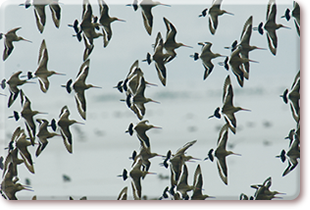
- To conserve local flora, fauna and natural habitats by offering professional advice on development proposals, planning strategies and environmental impact assessments;
- To draw up and implement biodiversity conservation plans, as well as to identify Sites of Special Scientific Interest (SSSI);
- To conduct regular ecological surveys, update inventories and manage an ecological database for Hong Kong;
- To control the release into the environment of genetically modified organisms, as well as their import and export;
- To monitor the ecology of the Mai Po Inner Deep Bay Ramsar Site and to develop and manage the Hong Kong Wetland Park;
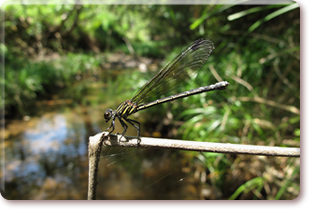 To protect endangered animal and plant species; and
To protect endangered animal and plant species; and- To promote public awareness of and participation in nature conservation through publicity and educational activities.
NATURAL ENVIRONMENT
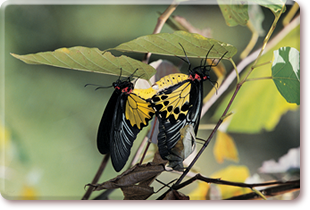
Hong Kong's topography and subtropical climate provide a wide range of habitats that support a rich variety of flora and fauna. Scenically, it has a great deal to offer – a landscape rising from sandy beaches and rocky foreshores to a height of almost 1,000 metres, with woodlands and hilly areas covered by open grassland, as well as a variety of scenic vistas rarely seen in such a small place.
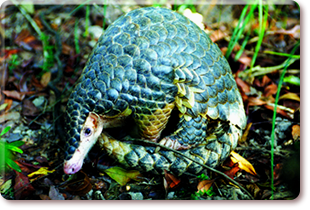 In Hong Kong, there are more than 3,300 species of vascular plants, of which about 2,100 are native; 55 species of terrestrial mammals; 510 species of birds; 185 species of freshwater fish; 86 species of reptiles and 24 amphibian species. Insect diversity is also very high with some 240 species of butterflies and 117 species of dragonflies.
In Hong Kong, there are more than 3,300 species of vascular plants, of which about 2,100 are native; 55 species of terrestrial mammals; 510 species of birds; 185 species of freshwater fish; 86 species of reptiles and 24 amphibian species. Insect diversity is also very high with some 240 species of butterflies and 117 species of dragonflies.
ENHANCED NATURE CONSERVATION
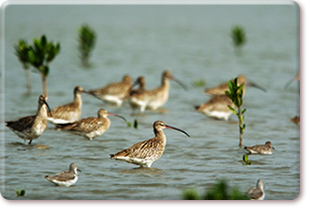
Under the New Nature Conservation Policy announced in November 2004, 12 priority sites have been identified for enhanced conservation through Public-Private Partnership (PPP) and Management Agreements (MA) with landowners. The Department is responsible for monitoring PPP and MA projects selected for implementation by the private sector or non-governmental organisations in these sites.
As at March 2013, there were 4 MA projects implemented at 4 priority sites. The 2 MA projects commenced in Long Valley and Fung Yuen since 2005 covered more than 16 hectares of private land. In March 2013, 2 other MA projects at Ramsar Site and Deep Bay Wetland Outside Ramsar Site covering over 330 and 400 hectares of fish ponds respectively commenced to sustain the efforts in promoting conservation management of fishponds in the Inner Deep Bay area. The increase in the number and diversity of birds in Long Valley and butterflies in Fung Yuen as well as the increased abundance of waterbirds at fishponds during drain-down suggested that the MA scheme was effective in enhancing the conservation value of the sites. In addition to the direct benefit to biodiversity, the projects also raised the conservation awareness of the public, local villagers and fish farmers.
ECOLOGICAL SURVEYS AND DATABASE
The Department has been conducting a territory-wide ecological survey programme since 2002 with a view to maintaining and updating an ecological database for the whole of Hong Kong. The survey programme covers all major habitats of high conservation value in Hong Kong, including the location, status and composition of feng shui woods, as well as the distribution and abundance of selected animal groups. As at March 2013, about 114,000 records of over 4,000 species of plants and animals had been collected, verified, and stored in the database.
The survey findings confirmed that Hong Kong has a rich biodiversity, including species new to Hong Kong and even new to science. The findings further indicated that a very significant portion of this biodiversity has been well preserved in our protected areas. For the species groups surveyed and analysed, over 98% of the terrestrial and freshwater species that are regularly seen in Hong Kong have representative population(s) inside our protected areas.
During the year, the Department continued to boost public interest in local biodiversity and arouse public awareness of nature conservation through its online database on representative species and habitats at Hong Kong Biodiversity Online and the Hong Kong Live Eco-map. The Department also developed a central database using the Geographical Information System which incorporated survey data and ecological information available from other sources.
THE MAI PO INNER DEEP BAY RAMSAR SITE
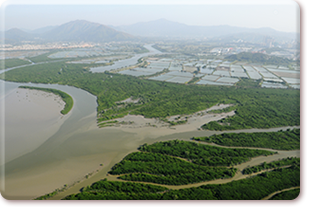
About 1,500 hectares of wetland in the Mai Po and Inner Deep Bay area was listed as a Ramsar Site in 1995. The Mai Po Inner Deep Bay Ramsar Site is located along the major migratory bird flyway “East Asian - Australasian Flyway” which is an important stopover site and habitat, supporting over 150 species of migratory and local waterbird species.
Since August 2001, the Department has implemented a baseline ecological monitoring programme for the Ramsar Site. This long-term monitoring programme aims to collect ecological baseline information on the benthic communities and the extent of wetland habitats at the Ramsar Site.
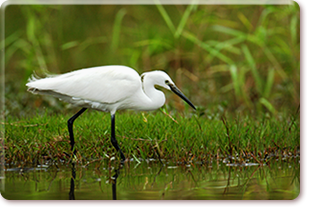 Commissioned by the Department, the Hong Kong Bird Watching Society has been carrying out a monthly waterbird monitoring programme for the Deep Bay area since 1997. From October 2012 to March 2013, the peak winter count of waterbirds at the Ramsar Site was 61,673, including 13,169 ducks and grebes, 22,320 shorebirds, 7,955 gulls and terns, 10,569 cormorants, 2,773 egrets and herons, and 163 rails and coots.
Commissioned by the Department, the Hong Kong Bird Watching Society has been carrying out a monthly waterbird monitoring programme for the Deep Bay area since 1997. From October 2012 to March 2013, the peak winter count of waterbirds at the Ramsar Site was 61,673, including 13,169 ducks and grebes, 22,320 shorebirds, 7,955 gulls and terns, 10,569 cormorants, 2,773 egrets and herons, and 163 rails and coots.
BLACK-FACED SPOONBILLS
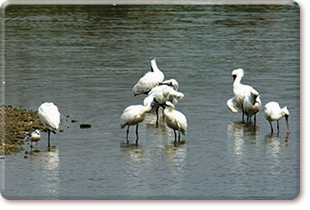
The Black-faced Spoonbill is a globally endangered species that can only be found in the East Asia region. In 2012-13 winter, the global population survey recorded 2,725 individuals. The highest count for wintering population in the Deep Bay area, which was recorded in January 2013, was 351 individuals, i.e. about 13% of them made the Inner Deep Bay area their winter or stop-over migration site. The area has the third largest number of wintering Black-faced Spoonbills in the world.
A conservation plan for Black-faced Spoonbills has been in place since 2001 which aims at maintaining the Mai Po Inner Deep Bay Ramsar Site in favourable conditions for the wintering Black-faced Spoonbills in Hong Kong. The plan also makes recommendations on measures for species and habitat protection and management, monitoring and research, education and training as well as regional cooperation.
SEA TURTLES
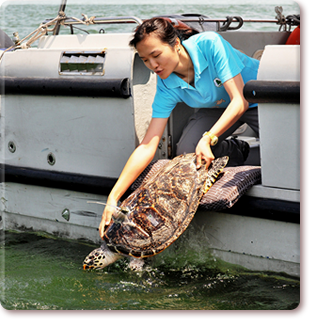
Green Turtle (Chelonia mydas) is the only sea turtle species that regularly breeds in Hong Kong. Various conservation measures have been put in place, including the designation of Sham Wan beach on Lamma Island as a restricted area during the nesting period of Green Turtles from June to October each year, regular patrols and public education about sea turtle conservation in Hong Kong. In 2012, we recorded that a nesting green turtle laid 5 clutches of eggs during the summer at Sham Wan, making a total of over 550 eggs. The same turtle has nested in Hong Kong in 2003 and 2008 and after each nesting, it returned to its feeding ground in Vietnam. Moreover, 2 Hawksbill Turtles (Eretmochelys imbricata), a critically endangered species rarely found in local 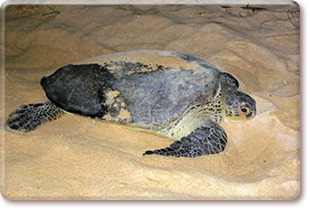 waters, were received from the public. After rehabilitation at the Ocean Park Hong Kong had been completed, they were released in June by the Department to the wild. With a view to understanding the movement of sea turtles and locating their foraging grounds in South China Sea, satellite transmitters were deployed on the turtles. Satellite tracking revealed that these turtles, including Green Turtles and Hawksbill Turtles, arrived at their foraging grounds in the Wanshan Archipelagos, Pratas (Dongsha) Islands, East Harbour of Fujian Province, the North of Philippines and Paracel (Xisha) Islands.
waters, were received from the public. After rehabilitation at the Ocean Park Hong Kong had been completed, they were released in June by the Department to the wild. With a view to understanding the movement of sea turtles and locating their foraging grounds in South China Sea, satellite transmitters were deployed on the turtles. Satellite tracking revealed that these turtles, including Green Turtles and Hawksbill Turtles, arrived at their foraging grounds in the Wanshan Archipelagos, Pratas (Dongsha) Islands, East Harbour of Fujian Province, the North of Philippines and Paracel (Xisha) Islands.
CONTROL OF TRADE IN ENDANGERED SPECIES
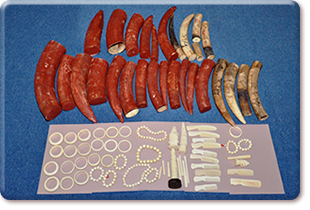
The Protection of Endangered Species of Animals and Plants Ordinance (Cap 586) is the local legislation which gives effect to the Convention on International Trade in Endangered Species of Wild Fauna and Flora (CITES). It strictly regulates the trade in endangered species.
During the year, efforts in combating illegal trade in endangered species continued. 409 seizures were made, including 5 pieces of rhino horn from Mozambique, 1,927 kg of ivory from Tanzania and 2,400 live rat snakes and 200 live cobra from Thailand.
The achievement of Hong Kong in enforcement has received recognition in the international arena. The Secretary-General of CITES awarded certificates of commendation to the Department to recognise its exemplary enforcement efforts in combating illegal trade of endangered species in 2003 and 2012.
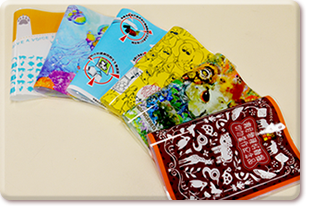
The Department continued its educational and promotional efforts to raise public awareness of the need to protect endangered species, such as organising visits to the Department's Endangered Species Resource Centre, conducting talks in schools and roving exhibitions at public venues, distributing posters and leaflets as well as arranging displays at the airport and border control points. The Department organised the Endangered Species Protection Passport Holder Design Competition which received good response with more than 1,700 entries.
Statistics on the control of trade in endangered species are at Appendix 12.
CONTROL OF GENETICALLY MODIFIED ORGANISMS
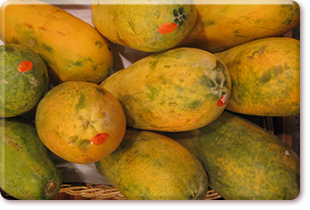
The Genetically Modified Organisms (Control of Release) Ordinance (the Ordinance) (Cap 607) controls the release into the environment, and the import and export, of genetically modified organisms (GMOs). Under the Ordinance, prior approval has to be sought from the Director of Agriculture, Fisheries and Conservation before a genetically modified organism (GMO) could be released or imported into Hong Kong for release into the local environment. In addition, shipments containing GMOs, when being imported or exported, have to be accompanied with prescribed documents to enable easy identification of the GMOs and to provide the contact points for further information. Detailed documentation requirements are laid down in the subsidiary legislation, the Genetically Modified Organisms (Documentation for Import and Export) Regulation.
The Genetically Modified Organisms (Control of Release) (Exemption) Notice (the Notice) which commenced on 23 June 2012, was made under the Ordinance to provide for the exemption of GM papaya and any GMO that is contained in a veterinary vaccine (i.e. live recombinant veterinary vaccine). The Notice exempts all varieties of GM papaya and live recombinant veterinary vaccine from the application of section 5 of the Ordinance, which provides that a person must not knowingly cause a GMO to be released into the environment or maintain the life of a GMO that is in a state of being released into the environment. The Notice also exempts 2 commercialised varieties of GM papaya (viz. the variety with the unique identifier code CUH-CP551-8 and the variety with the transformation event code Huanong 1) and any GMO that is contained in a veterinary vaccine from the application of section 7, which provides that a person must not knowingly import a GMO that is intended for release into the environment.
The Department launched a number of educational and publicity activities to enhance public awareness and understanding of the Ordinance, which included distributing pamphlets to the general public and stakeholders, broadcasting videos at the airport, displaying posters at some MTR stations, organising roving exhibitions and updating the online GMOs Register. Also, circular letters were disseminated to all relevant stakeholders to notify them of the latest news and information about the Ordinance.
THE HONG KONG WETLAND PARK
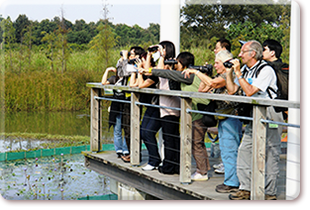
Opened in May 2006, the Hong Kong Wetland Park is a landmark in wetland conservation, with a mission to promote eco-tourism in Hong Kong and foster public awareness of the values of wetlands. The Park combines the natural beauty of 60 hectares of re-created wetland with a visitor centre of over 10,000 square metres showcasing sophisticated exhibits on wetlands. During the year, the Park attracted about 490,000 visitors.
The Department is responsible for the management of the Park, with respect to daily operation, education and community services, exhibit maintenance, habitat management and marketing promotion.
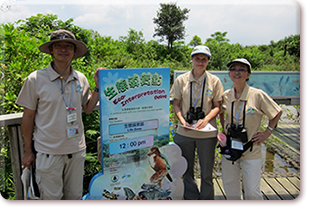
In 2012-13, the Park organised a wide range of activities for some 190,000 visitors of all ages including guided tours, seminars, wildlife watching classes, contests, dramas, art workshops and thematic events.
The Park offered guided visit programmes to students from kindergartens to senior secondary schools. In 2012-13, the Park conducted over 820 guided tours for more than 19,500 students. In addition, the Park organised exhibitions, talks, teacher's workshops and partnership programmes to support wetland education in schools. About 20 teacher’s workshops were organised in the year to enhance teachers’ knowledge in conducting education activities at the Park.
For the general public, the Park organised 13 public lectures for about 900 visitors during the year. Various thematic events were organised to tie in with public holidays and major festivals, such as Bird Watching Festival, Blossom on Wetland, Bouncy Wetlands and World Wetlands Day Celebrations.
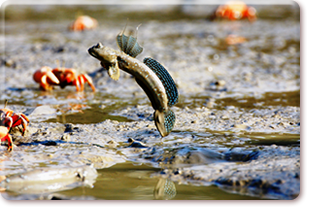
The Park continued to work with different sectors to promote the awareness of wetland conservation throughout the community. The Hong Kong Wetland Park Volunteer Scheme recruited about 1,300 volunteers in 2012-13. They assisted in the operation of the visitor centre and habitat management, and offered guided tours for visitors. The Park also established partnership programmes with corporations and non-governmental organisations to draw expertise and resources into the force of wetland conservation.
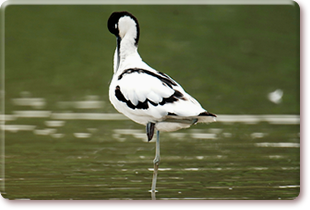 The Park plays an important role in promoting wetland conservation and education in the Asia Pacific region. Being an active player of the Wetland Link International – Asia (WLI-Asia) network, the Park organised student exchange programmes with wetland centres in the region.
The Park plays an important role in promoting wetland conservation and education in the Asia Pacific region. Being an active player of the Wetland Link International – Asia (WLI-Asia) network, the Park organised student exchange programmes with wetland centres in the region.
Since 2003, the Department has been conducting habitat management at the Wetland Reserve with a view to enhancing its ecological functions. The species richness of birds recorded has since increased, and the cumulative number of bird species recorded has exceeded 242. Waterbirds or birds dependent on wetlands make up approximately 47% of all species recorded. In addition to birds, ecological surveys conducted at the Reserve have recorded a variety of other species especially the wetland indicators – dragonflies, amphibians and reptiles. The cumulative numbers of dragonfly, amphibian and reptile species recorded at the Reserve are 52, 9 and 28 respectively. This shows that, with proper site design and management, the objectives of nature conservation, education and tourism can co-exist.
HONG KONG HERBARIUM AND FLORA CONSERVATION
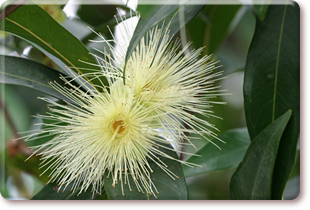 The Department manages the Hong Kong Herbarium which is responsible for the systematic collection, identification and maintenance of plant specimens of Hong Kong's flora. During the year, the specimen collection of the Herbarium exceeded 42,700, more than 290 of which are type specimens, making the Herbarium regionally important.
The Department manages the Hong Kong Herbarium which is responsible for the systematic collection, identification and maintenance of plant specimens of Hong Kong's flora. During the year, the specimen collection of the Herbarium exceeded 42,700, more than 290 of which are type specimens, making the Herbarium regionally important.
The Hong Kong Herbarium collaborated with the South China Botanical Garden in compiling the Flora of Hong Kong. It is a definitive technical reference aiming at recording all known plant species in Hong Kong, and is the first book about flora of South China written in English and fully illustrated with botanical drawings and colour photographs. Volumes 1 to 4, and Master Index of the Flora of Hong Kong were published in 2007 - 2012. They have been well received by local and overseas academics as well as plant workers.
The Herbarium is functioning as a resource centre for plant workers for its collection of specimens, associated field notes and botanical literature offering good reference materials to botanists who wish to study about the local flora. In addition, the Herbarium aims to promote public awareness of local flora through organising guided visits, publishing educational materials and managing the “Hong Kong Plant Database” which provides basic information of more than 3300 plant species with over 6,000 photos via the website of the Hong Kong Herbarium.
SITES OF SPECIAL SCIENTIFIC INTEREST
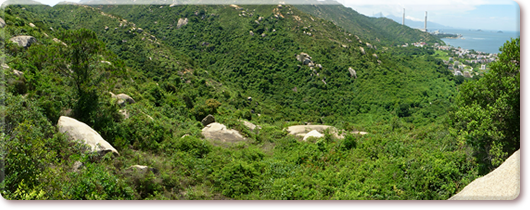 Sites of Special Scientific Interest (SSSI) may be land-based or aquatic sites, which are of special scientific interest because of their flora, fauna, geographical or geological features. During the year, the Department continued to patrol and monitor the conditions and scientific values of all SSSIs. Where warranted, the Department also carried out appropriate habitat management work at some SSSIs to maintain or enhance their scientific value. For instance, Mikania control was conducted at A Chau SSSI to improve the conditions of the trees there so as to provide a suitable site for egrets and
Sites of Special Scientific Interest (SSSI) may be land-based or aquatic sites, which are of special scientific interest because of their flora, fauna, geographical or geological features. During the year, the Department continued to patrol and monitor the conditions and scientific values of all SSSIs. Where warranted, the Department also carried out appropriate habitat management work at some SSSIs to maintain or enhance their scientific value. For instance, Mikania control was conducted at A Chau SSSI to improve the conditions of the trees there so as to provide a suitable site for egrets and 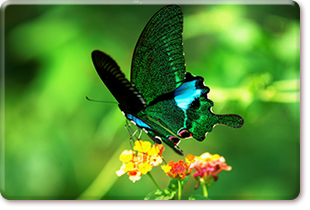 herons to nest. Butterfly host plants were planted at Fung Yuen Valley SSSI to enhance the butterfly habitat. The Department also continued to review the status of SSSIs and identify new sites suitable for SSSI listing or make proposals for de-listing those sites no longer deserving the SSSI status due to changes in circumstances over time after their listing. In April 2012, a new SSSI was designated at Lung Kwu Tan Valley for the protection of one of the most important butterfly habitats in Hong Kong. Up to 2012-13, there are 67 sites listed in the SSSI register.
herons to nest. Butterfly host plants were planted at Fung Yuen Valley SSSI to enhance the butterfly habitat. The Department also continued to review the status of SSSIs and identify new sites suitable for SSSI listing or make proposals for de-listing those sites no longer deserving the SSSI status due to changes in circumstances over time after their listing. In April 2012, a new SSSI was designated at Lung Kwu Tan Valley for the protection of one of the most important butterfly habitats in Hong Kong. Up to 2012-13, there are 67 sites listed in the SSSI register.
CONTROL OF WILD MONKEYS
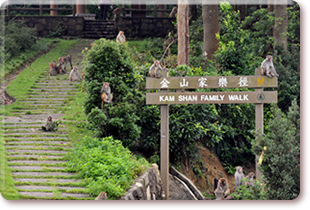 The wild monkey population in Hong Kong had increased in the past years and has caused public concern. To control the population increase in the long term, the Department has stepped up the field trial of contraceptive treatment. In 2012-13, the Department carried out such treatment on 319 monkeys. The Department also strengthened the enforcement of feeding ban in specific country parks to minimise monkey nuisance to visitors. During the year, a total of 75 country park visitors were prosecuted for unauthorised feeding of wild monkeys. With the implementation of both the feeding ban and the contraceptive programme, it is observed that there is a decreasing trend in the population of wild monkeys as well as the number of wild monkey nuisance cases.
The wild monkey population in Hong Kong had increased in the past years and has caused public concern. To control the population increase in the long term, the Department has stepped up the field trial of contraceptive treatment. In 2012-13, the Department carried out such treatment on 319 monkeys. The Department also strengthened the enforcement of feeding ban in specific country parks to minimise monkey nuisance to visitors. During the year, a total of 75 country park visitors were prosecuted for unauthorised feeding of wild monkeys. With the implementation of both the feeding ban and the contraceptive programme, it is observed that there is a decreasing trend in the population of wild monkeys as well as the number of wild monkey nuisance cases.